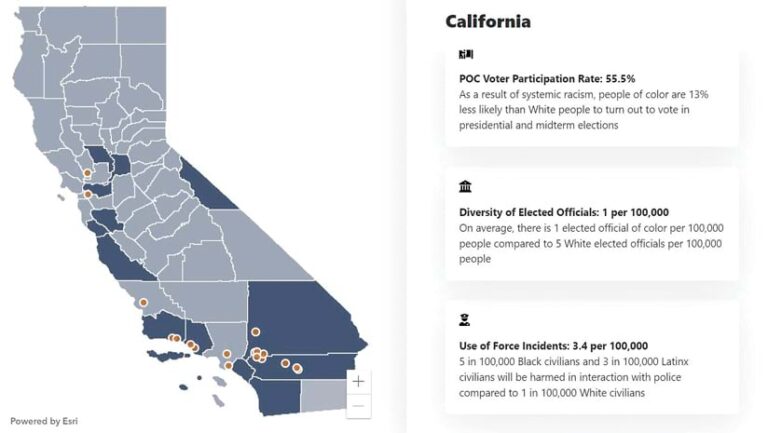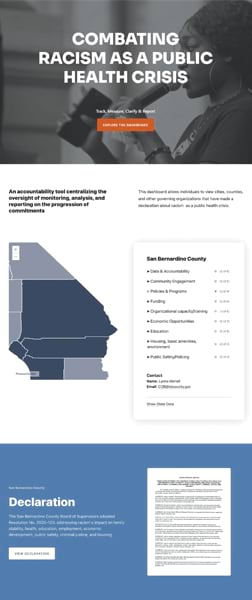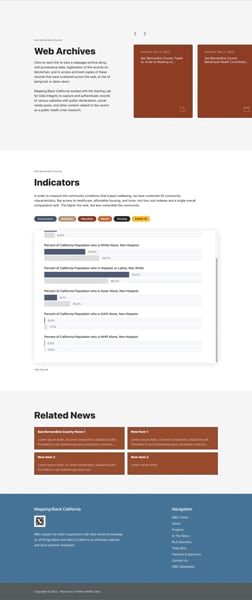In a 1967 speech at Stanford University in California, the Black American minister, activist, and civil rights leader Dr. Martin Luther King Jr. said that America’s promises of freedom and justice for Black Americans had not been met and that the United States’ summer riots were a result of the country’s winters of delay.

During this speech, King spoke of “genuine equality,” an ideal that was indicated by US legislation such as the Fourteenth Amendment, which in 1868 extended “equal protection of the laws” to all US citizens.
More than 50 years later, King’s call for accountability is being echoed in the Combating Racism as a Public Health Crisis dashboard, created by a group called Mapping Black California. The data arm of Black Voice News—the first Black American online news publication on the West Coast—Mapping Black California received help from Stanford University data integrity specialists and Esri user interface experts working with ArcGIS Online and ArcGIS Maps SDK for JavaScript.
A US Public Health Crisis
Driven in part by a nationwide uproar over the 2020 murder of Black American George Floyd by a police officer in Minneapolis, Minnesota, racism has been officially declared a public health crisis, a public health emergency, or something similar hundreds of times across dozens of US states in recent years, according to the American Public Health Association. The association also says that California accounts for more of these declarations than any other state.
But what legal power do these declarations and resolutions have? Are they simply acknowledgements of systemic racism? Do they come with actual and measurable commitments? Or are they what King might have called empty promises of freedom and justice?

Whatever these declarations mean, staff at Mapping Black California want to make sure that government officials who express their commitment are also acting on it. As stated on its website, Mapping Black California equips California’s population with data-driven knowledge of Black American issues, with the goal of eliminating regional and local systemic inequities.
“Whenever a racially motivated trauma occurs in Black communities, the government frequently makes declarations of empty promises,” said Mapping Black California project director Candice Mays. “The intent behind the Combating Racism platform is to ensure that this is not the case with racism-as-a-public-health-crisis declarations in the State of California.”
Mapping Black California project manager Alex Reed added that resolutions and declarations related to systemic racism “are an important first step to advancing racial equity and justice and must be followed by allocation of resources and strategic action.”
Keeping Promises, Literally and Figuratively
The Mapping Black California team began the first phase of its accountability effort by tracking public records and declarations of racial inequity. The second phase of the project, which was supported by a fellowship from Stanford University’s Starling Lab for Data Integrity, integrated Web3 authentication technology to track, verify, and report on the progress of the commitments outlined in the declarations.
Starling Lab staff used decentralized tools and blockchain protocols to go beyond simple screenshot captures of web content. They employed Webrecorder to collect and authenticate the web pages’ full context and used tools, platforms, and protocols that work with blockchain technology—such as InterPlanetary File System (IPFS), Filecoin, Avalanche, LikeCoin, and OpenTimestamps—to help ensure that saved web content is complete, accurate, and authentic. Pledges and promises, which can be deleted or hidden from social media and websites with the click of a button, are cryptographically sealed and stored—not only for posterity, but also for accountability.

Preserving the declarations and corresponding materials in this way enables concerned community members to determine a particular jurisdiction’s declaration status, assess its progress, and identify local contacts to see if and how racial equity changes are proceeding.
Visualizing Racial Equity Promises
The third phase of the project involved creating a fully integrated, content-aggregated platform. Published in November 2023, the platform preserves hundreds of web pages from California government sites and other online resources. It includes data to track whether actions followed promises, plus maps to help platform users focus on particular places.
To create the dashboard, accessible at combatingracism.com, Mapping Black California researchers modeled an American Public Health Association map that tracked the creation of declarations across the US on state, county, and city levels. Mapping Black California then worked with Starling Lab and Esri experts to adapt the dashboard to show racially relevant federal and state data—along with local and regional changes to the declaration template in regard to funding, community engagement, and education—related to systemic racism. The Esri team used ArcGIS Online to host and publish the data and build the California map, and ArcGIS Maps SDK for JavaScript to integrate the map and data into Mapping Black California’s website.
It’s a novel approach to an old but ever-changing issue, according to Mays.
“As the tools used to inflict racism upon our communities continue to evolve, we must not just evolve with them but ahead of them,” Mays said. This platform, she added, “is an exercise in that evolution.”

